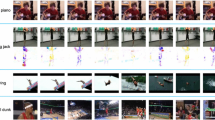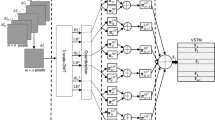Abstract
Motivated by the previous success of Two-Dimensional Convolutional Neural Network (2D CNN) on image recognition, researchers endeavor to leverage it to characterize videos. However, one limitation of applying 2D CNN to analyze videos is that different frames of a video share the same 2D CNN kernels, which may result in repeated and redundant information utilization, especially in the spatial semantics extraction process, hence neglecting the critical variations among frames. In this paper, we attempt to tackle this issue through two ways. 1) Design a sequential channel filtering mechanism, i.e., Progressive Enhancement Module (PEM), to excite the discriminative channels of features from different frames step by step, and thus avoid repeated information extraction. 2) Create a Temporal Diversity Loss (TD Loss) to force the kernels to concentrate on and capture the variations among frames rather than the image regions with similar appearance. Our method is evaluated on benchmark temporal reasoning datasets Something-Something V1 and V2, and it achieves visible improvements over the best competitor by \(2.4\%\) and \(1.3\%\), respectively. Besides, performance improvements over the 2D-CNN-based state-of-the-arts on the large-scale dataset Kinetics are also witnessed.
J. Weng and D. Luo—Equal contribution. This work is done when Junwu Weng is an intern at Youtu Lab.
Access this chapter
Tax calculation will be finalised at checkout
Purchases are for personal use only
Similar content being viewed by others
References
Carreira, J., Zisserman, A.: Quo vadis, action recognition? a new model and the kinetics dataset. In: CVPR, pp. 6299–6308 (2017)
Choi, J., Gao, C., Messou, J.C., Huang, J.B.: Why can’t i dance in the mall, learning to mitigate scene bias in action recognition. In: NeurIPS, pp. 853–865 (2019)
Deng, J., Dong, W., Socher, R., Li, L.J., Li, K., Fei-Fei, L.: Imagenet: a large-scale hierarchical image database. In: CVPR, pp. 248–255. IEEE (2009)
Feichtenhofer, C., Fan, H., Malik, J., He, K.: Slowfast networks for video recognition. In: ICCV, pp. 6202–6211 (2019)
Goyal, R., et al.: The “something something” video database for learning and evaluating visual common sense. In: ICCV, vol. 1, p. 5 (2017)
He, K., Zhang, X., Ren, S., Sun, J.: Deep residual learning for image recognition. In: CVPR, pp. 770–778 (2016)
Hu, J., Shen, L., Sun, G.: Squeeze-and-excitation networks. In: CVPR, pp. 7132–7141 (2018)
Jiang, Y.-G., Dai, Q., Xue, X., Liu, W., Ngo, C.-W.: Trajectory-based modeling of human actions with motion reference points. In: Fitzgibbon, A., Lazebnik, S., Perona, P., Sato, Y., Schmid, C. (eds.) ECCV 2012. LNCS, vol. 7576, pp. 425–438. Springer, Heidelberg (2012). https://doi.org/10.1007/978-3-642-33715-4_31
Li, Y., Song, S., Li, Y., Liu, J.: Temporal bilinear networks for video action recognition. In: AAAI, vol. 33, pp. 8674–8681 (2019)
Lin, J., Gan, C., Han, S.: Tsm: Temporal shift module for efficient video understanding. In: ICCV, pp. 7083–7093 (2019)
Liu, Z., et al.: Teinet: towards an efficient architecture for video recognition. In: AAAI, vol. 2, p. 8 (2020)
Lu, X., Ma, C., Ni, B., Yang, X., Reid, I., Yang, M.-H.: Deep regression tracking with shrinkage loss. In: Ferrari, V., Hebert, M., Sminchisescu, C., Weiss, Y. (eds.) Computer Vision – ECCV 2018. LNCS, vol. 11218, pp. 369–386. Springer, Cham (2018). https://doi.org/10.1007/978-3-030-01264-9_22
Lu, X., Wang, W., Ma, C., Shen, J., Shao, L., Porikli, F.: See more, know more: Unsupervised video object segmentation with co-attention siamese networks. In: CVPR, pp. 3623–3632 (2019)
Lu, X., Wang, W., Shen, J., Tai, Y.W., Crandall, D.J., Hoi, S.C.: Learning video object segmentation from unlabeled videos. In: CVPR, pp. 8960–8970 (2020)
Luo, C., Yuille, A.L.: Grouped spatial-temporal aggregation for efficient action recognition. In: ICCV, pp. 5512–5521 (2019)
Mahdisoltani, F., Berger, G., Gharbieh, W., Fleet, D., Memisevic, R.: On the effectiveness of task granularity for transfer learning. arXiv:1804.09235 (2018)
Qiu, Z., Yao, T., Ngo, C.W., Tian, X., Mei, T.: Learning spatio-temporal representation with local and global diffusion. In: CVPR, pp. 12056–12065 (2019)
Simonyan, K., Zisserman, A.: Very deep convolutional networks for large-scale image recognition. In: ICLR (2014)
Szegedy, C., et al.: Going deeper with convolutions. In: CVPR, pp. 1–9 (2015)
Tran, D., Bourdev, L., Fergus, R., Torresani, L., Paluri, M.: Learning spatiotemporal features with 3D convolutional networks. In: ICCV, pp. 4489–4497 (2015)
Tran, D., Wang, H., Torresani, L., Ray, J., LeCun, Y., Paluri, M.: A closer look at spatiotemporal convolutions for action recognition. In: CVPR, pp. 6450–6459 (2018)
Wang, L., Li, W., Li, W., Van Gool, L.: Appearance-and-relation networks for video classification. In: CVPR, pp. 1430–1439 (2018)
Wang, L., Xiong, Y., Wang, Z., Qiao, Yu., Lin, D., Tang, X., Van Gool, L.: Temporal segment networks: towards good practices for deep action recognition. In: Leibe, B., Matas, J., Sebe, N., Welling, M. (eds.) ECCV 2016. LNCS, vol. 9912, pp. 20–36. Springer, Cham (2016). https://doi.org/10.1007/978-3-319-46484-8_2
Wang, X., Farhadi, A., Gupta, A.: Actions transformations. In: CVPR, pp. 2658–2667 (2016)
Wang, X., Girshick, R., Gupta, A., He, K.: Non-local neural networks. In: CVPR, pp. 7794–7803 (2018)
Wang, X., Gupta, A.: Videos as space-time region graphs. In: Ferrari, V., Hebert, M., Sminchisescu, C., Weiss, Y. (eds.) ECCV 2018. LNCS, vol. 11209, pp. 413–431. Springer, Cham (2018). https://doi.org/10.1007/978-3-030-01228-1_25
Wang, Y., Hoai, M.: Pulling actions out of context, explicit separation for effective combination. In: CVPR, pp. 7044–7053 (2018)
Xie, S., Sun, C., Huang, J., Tu, Z., Murphy, K.: Rethinking spatiotemporal feature learning: speed-accuracy trade-offs in video classification. In: Ferrari, V., Hebert, M., Sminchisescu, C., Weiss, Y. (eds.) ECCV 2018. LNCS, vol. 11219, pp. 318–335. Springer, Cham (2018). https://doi.org/10.1007/978-3-030-01267-0_19
Xingjian, S., Chen, Z., Wang, H., Yeung, D.Y., Wong, W.K., Woo, W.c.: Convolutional LSTM network: a machine learning approach for precipitation nowcasting. In: NeurIPS, pp. 802–810 (2015)
Zhang, P., Lan, C., Xing, J., Zeng, W., Xue, J., Zheng, N.: View adaptive recurrent neural networks for high performance human action recognition from skeleton data. In: ICCV, pp. 2117–2126 (2017)
Zhao, B., Wu, X., Feng, J., Peng, Q., Yan, S.: Diversified visual attention networks for fine-grained object classification. T-MM 19(6), 1245–1256 (2017)
Zheng, H., Fu, J., Mei, T., Luo, J.: Learning multi-attention convolutional neural network for fine-grained image recognition. In: CVPR, pp. 5209–5217 (2017)
Zhou, B., Andonian, A., Oliva, A., Torralba, A.: Temporal relational reasoning in videos. In: Ferrari, V., Hebert, M., Sminchisescu, C., Weiss, Y. (eds.) ECCV 2018. LNCS, vol. 11205, pp. 831–846. Springer, Cham (2018). https://doi.org/10.1007/978-3-030-01246-5_49
Zhu, X., Xu, C., Hui, L., Lu, C., Tao, D.: Approximated bilinear modules for temporal modeling. In: ICCV, pp. 3494–3503 (2019)
Acknowledgement
We thank Dr. Wei Liu from Tencent AI Lab for his valuable advice.
Author information
Authors and Affiliations
Corresponding author
Editor information
Editors and Affiliations
Rights and permissions
Copyright information
© 2020 Springer Nature Switzerland AG
About this paper
Cite this paper
Weng, J. et al. (2020). Temporal Distinct Representation Learning for Action Recognition. In: Vedaldi, A., Bischof, H., Brox, T., Frahm, JM. (eds) Computer Vision – ECCV 2020. ECCV 2020. Lecture Notes in Computer Science(), vol 12352. Springer, Cham. https://doi.org/10.1007/978-3-030-58571-6_22
Download citation
DOI: https://doi.org/10.1007/978-3-030-58571-6_22
Published:
Publisher Name: Springer, Cham
Print ISBN: 978-3-030-58570-9
Online ISBN: 978-3-030-58571-6
eBook Packages: Computer ScienceComputer Science (R0)




